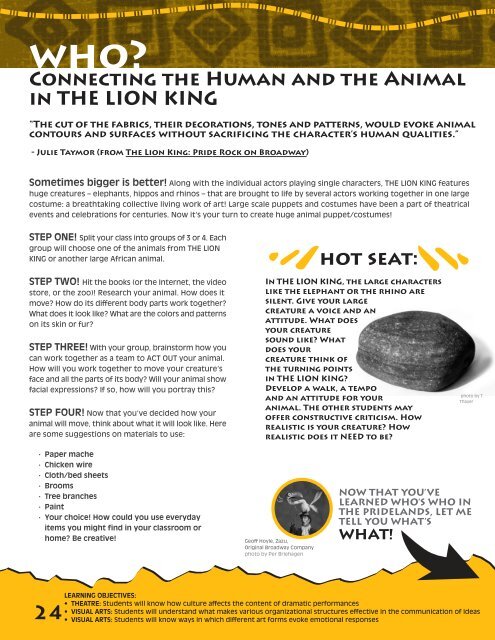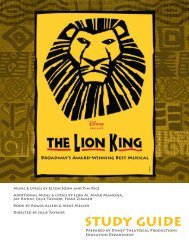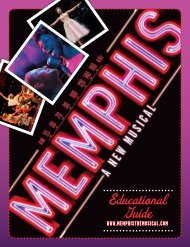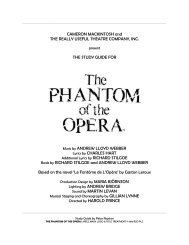The Lion King Study Guide - Telecharge
The Lion King Study Guide - Telecharge
The Lion King Study Guide - Telecharge
Create successful ePaper yourself
Turn your PDF publications into a flip-book with our unique Google optimized e-Paper software.
who?<br />
Connecting the Human and the Animal<br />
in THE LION KING<br />
“<strong>The</strong> cut of the fabrics, their decorations, tones and patterns, would evoke animal<br />
contours and surfaces without sacrificing the character’s human qualities.”<br />
- Julie Taymor (from <strong>The</strong> <strong>Lion</strong> <strong>King</strong>: Pride Rock on Broadway)<br />
Sometimes bigger is better! Along with the individual actors playing single characters, THE LION KING features<br />
huge creatures – elephants, hippos and rhinos – that are brought to life by several actors working together in one large<br />
costume: a breathtaking collective living work of art! Large scale puppets and costumes have been a part of theatrical<br />
events and celebrations for centuries. Now it’s your turn to create huge animal puppet/costumes!<br />
STEP ONE! Split your class into groups of 3 or 4. Each<br />
group will choose one of the animals from THE LION<br />
KING or another large African animal.<br />
STEP TWO! Hit the books (or the Internet, the video<br />
store, or the zoo)! Research your animal. How does it<br />
move? How do its different body parts work together?<br />
What does it look like? What are the colors and patterns<br />
on its skin or fur?<br />
STEP THREE! With your group, brainstorm how you<br />
can work together as a team to ACT OUT your animal.<br />
How will you work together to move your creature’s<br />
face and all the parts of its body? Will your animal show<br />
facial expressions? If so, how will you portray this?<br />
STEP FOUR! Now that you’ve decided how your<br />
animal will move, think about what it will look like. Here<br />
are some suggestions on materials to use:<br />
· Paper mache<br />
· Chicken wire<br />
· Cloth/bed sheets<br />
· Brooms<br />
· Tree branches<br />
· Paint<br />
· Your choice! How could you use everyday<br />
items you might find in your classroom or<br />
home? Be creative!<br />
24<br />
hot seat:<br />
In THE LION KING, the large characters<br />
like the elephant or the rhino are<br />
silent. Give your large<br />
creature a voice and an<br />
attitude. What does<br />
your creature<br />
sound like? What<br />
does your<br />
creature think of<br />
the turning points<br />
in THE LION KING?<br />
Develop a walk, a tempo<br />
and an attitude for your<br />
animal. <strong>The</strong> other students may<br />
offer constructive criticism. How<br />
realistic is your creature? How<br />
realistic does it NEED to be?<br />
Geoff Hoyle, Zazu,<br />
Original Broadway Company<br />
photo by Per Briehagen<br />
photo by T.<br />
Thayer<br />
NOW THAT YOU’VE<br />
LEARNED WHO’S WHO IN<br />
THE PRIDELANDS, LET ME<br />
TELL YOU WHAT’S<br />
WHAT!<br />
LEARNING OBJECTIVES:<br />
• THEATRE: Students will know how culture affects the content of dramatic performances<br />
• VISUAL ARTS: Students will understand what makes various organizational structures effective in the communication of ideas<br />
• VISUAL ARTS: Students will know ways in which different art forms evoke emotional responses





